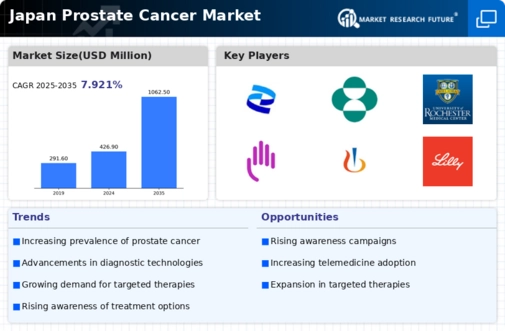Growing Awareness and Education
Rising awareness about prostate cancer among the Japanese population is a significant driver for the market. Educational campaigns focusing on risk factors, symptoms, and the importance of regular screenings are gaining traction. This heightened awareness is likely to lead to increased screening rates, which can facilitate earlier diagnosis and treatment. The prostate cancer market is expected to see a positive impact from these efforts, as more men become proactive about their health. Surveys indicate that awareness initiatives could increase screening participation by up to 30%, thereby driving demand for diagnostic and therapeutic services in the coming years.
Government Initiatives and Funding
Government initiatives aimed at cancer control are pivotal for the prostate cancer market. In Japan, the Ministry of Health, Labour and Welfare has implemented various programs to enhance cancer screening and treatment accessibility. Increased funding for prostate cancer research and public awareness campaigns is likely to bolster early detection efforts. The prostate cancer market stands to benefit from these initiatives, as they promote the development of innovative therapies and improve patient education. With government support, the market is projected to expand, potentially increasing the number of men screened and treated for prostate cancer, thereby reducing mortality rates.
Aging Population and Rising Incidence
The aging population in Japan is a critical driver for the prostate cancer market. As men age, the risk of developing prostate cancer increases significantly, with studies indicating that approximately 1 in 8 men will be diagnosed with the disease in their lifetime. This demographic shift is expected to lead to a higher incidence rate, thereby increasing the demand for screening and treatment options. The prostate cancer market is likely to experience growth as healthcare providers focus on early detection and management strategies tailored to older patients. Furthermore, the prevalence of prostate cancer among men aged 65 and older is projected to rise, necessitating advancements in therapeutic interventions and supportive care services.
Emerging Treatment Options and Therapies
The introduction of novel treatment options is reshaping the prostate cancer market. Innovative therapies, including targeted therapies and immunotherapy, are becoming more prevalent in Japan. These advancements offer new hope for patients, particularly those with advanced stages of the disease. The prostate cancer market is likely to experience growth as these therapies gain regulatory approval and become integrated into standard treatment protocols. Market analysts project that the segment for advanced therapies could grow by approximately 20% over the next five years, reflecting the increasing demand for effective treatment solutions that cater to diverse patient needs.
Technological Advancements in Diagnostics
Technological innovations in diagnostic tools are transforming the prostate cancer market. Enhanced imaging techniques, such as multiparametric MRI and advanced biopsy methods, are improving the accuracy of prostate cancer detection. These advancements enable earlier diagnosis and more precise treatment planning, which is crucial in a country like Japan, where early intervention can significantly impact patient outcomes. The prostate cancer market is witnessing increased adoption of these technologies, with a reported growth rate of approximately 15% in the diagnostic segment. As healthcare facilities invest in state-of-the-art equipment, the overall efficiency and effectiveness of prostate cancer management are expected to improve, ultimately benefiting patient care.























Leave a Comment